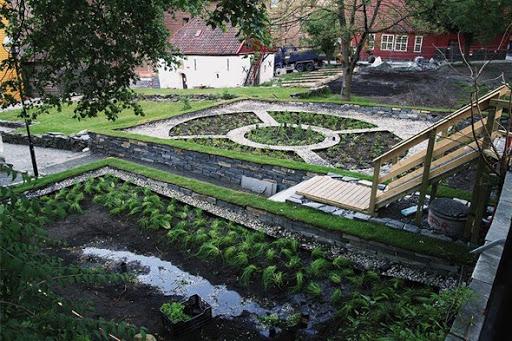Last updated: October 2021
Bryggen, the old wharf of Bergen, is a reminder of the town’s importance as part of the Hanseatic League’s trading empire from the 14th to the mid-16th century and is on UNESCO's list of the world's cultural heritage. For about 30 years, large amounts of groundwater leaked, threatening the survival of the ancient site. In order to address this, sustainable water treatment and climate adaptation measures (involving the largest rain garden of Norway, swales etc.) at Bryggen were used to restore the water balance at Bryggen. (Ref. 1)
Overview
Nature-based solution
- Blue infrastructure
- Coastlines
- Green areas for water management
- Rain gardens
- Swales and filter strips
- Sustainable urban drainage systems
Key challenges
- Climate action for adaptation, resilience and mitigation (SDG 13)
- Climate change adaptation
- Water management (SDG 6)
- Stormwater and rainfall management and storage
- Improvements to water quality
- Regeneration, land-use and urban development
- Regulation of built environment
- Cultural heritage and cultural diversity
- Protection of historic and cultural landscape/infrastructure
Focus
Creation of new green areas, Management and improved protection of rivers and other blue areas
Project objectives
This NBS aimed to develop measurements that stabilize the groundwater, improve the preservation opportunities of the cultural heritage and reduce the uneven subsidence under the buildings (Ref. 2).
Objectives included (Ref. 1):
• Reducing groundwater flow to a minimum
• Reducing the diffusion of oxygen into the ground
• Ensuring a minimum of intervention in intact archaeological deposits
Implementation activities
Installing swales and a 150m2 rain garden with 700 plants.
(Ref. 1)
Drilling pipes, pumps and tanks to reestablish groundwater's original height.
Establishing rain gardens to let the water drain into the ground rather than be transported as runoff on dense surface areas.
Having constructive meetings and close dialogue with, among others, the urban antiquary in terms of cultural-historical conditions
Plant selection was based on historical perspective and water tolerance.
Construction engineering of rainfall with the function of retaining water in order to preserve the cultural history, but at the same time allow for drainage.
Structure of plant areas based on Norways Water and Energy Directorate's (NVE) report on the arrangement of rain gardens.
Ongoing geotechnical assessments.
(Ref. 2)
Climate-focused activities
Climate change adaptation:
- Implement sustainable urban drainage infrastructure (e.g. to make space for water)
Main beneficiaries
- National-level government
- Local government/Municipality
- Private sector/Corporate/Company
- Citizens or community groups
Governance
Management set-up
- Government-led
Type of initiating organisation
- National government
- Local government/municipality
Participatory approaches/ community involvement
- Unknown
Details on the roles of the organisations involved in the project
National/ Local Government: The National Antiquary, Hordaland County municipality and Bergen Municipality at The Urban Antiquary have been responsible for the whole Project of Bryggen (Ref. 3). Funding is provided by the National Government (Ref. 3,4).
Private Sector: Multiconsult AS have been the project consultants for the rain garden and water management of the site, and Statsbygg was the builder and of the rain garden and the other water management installations (Ref. 2)
Project implemented in response to ...
... an EU policy or strategy?
Unknown
... a national policy or strategy?
Unknown
... a local policy or strategy?
Unknown
Financing
Total cost
More than €4,000,000
Source(s) of funding
- Public national budget
Type of funding
- Direct funding (grants, subsidies, or self-financed projects by private entities)
Non-financial contribution
Unknown
Impacts and Monitoring
Environmental impacts
- Climate change
- Strengthened capacity to address climate hazards/natural disasters
- Water management and blue areas
- Increased protection against flooding
- Improved stormwater management
- Green space and habitat
- Increased green space area
Economic impacts
- Unknown
Socio-cultural impacts
- Cultural heritage and sense of place
- Protection of historic and cultural landscape / infrastructure
Type of reported impacts
Achieved impacts
Presence of formal monitoring system
Yes
Presence of indicators used in reporting
Yes
Presence of monitoring/ evaluation reports
Yes
Availability of a web-based monitoring tool
No evidence in public records
References
1. Riksantikvaren (2015) Monitoring, Mitigation, Management, The Groundwater Project – Safeguarding the World Heritage Site of Bryggen in Bergen. ISBN 978-82-7574-087-6.
2. Multiconsult (2010). Bryggen in Bergen, Groundwater Management - Rain Garden/Bryggen i Bergen Grunnvanshåndtering – Regnbed. [Document provided].
3. Prosjekt Bryggen (n.d.). Maintenance of the World Heritage Site, Actors/Forvaltning av verdensarvstedet, Aktørene. Available at: Source link [Accessed: 26 October 2020].
4. Prosjekt Bryggen (n.d.). Project Bryggen/Prosjekt Bryggen. Available at: Source link [Accessed: 26 October 2020].
5. City of Bergen (2016). Green Strategy. Climate and Energy Action plan for Bergen/Grønn strategi. Klima- og Energihandlingsplan for Bergen. Behandlet av Byråd 26. mai. 2016. Available at: Source link [Accessed: 26 October 2020].
6. Norske lanskapsarkitekters forening (NLA) (n.d.). Rain garden Bryggen in Bergen/Regnbed Bryggen i Bergen. Available at: Source link [Accessed: 26 October 2020].
2. Multiconsult (2010). Bryggen in Bergen, Groundwater Management - Rain Garden/Bryggen i Bergen Grunnvanshåndtering – Regnbed. [Document provided].
3. Prosjekt Bryggen (n.d.). Maintenance of the World Heritage Site, Actors/Forvaltning av verdensarvstedet, Aktørene. Available at: Source link [Accessed: 26 October 2020].
4. Prosjekt Bryggen (n.d.). Project Bryggen/Prosjekt Bryggen. Available at: Source link [Accessed: 26 October 2020].
5. City of Bergen (2016). Green Strategy. Climate and Energy Action plan for Bergen/Grønn strategi. Klima- og Energihandlingsplan for Bergen. Behandlet av Byråd 26. mai. 2016. Available at: Source link [Accessed: 26 October 2020].
6. Norske lanskapsarkitekters forening (NLA) (n.d.). Rain garden Bryggen in Bergen/Regnbed Bryggen i Bergen. Available at: Source link [Accessed: 26 October 2020].


